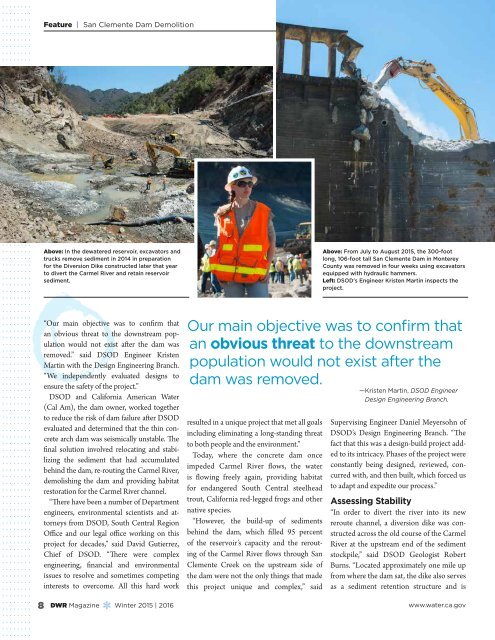Restored
dwr_mag_w16
dwr_mag_w16
You also want an ePaper? Increase the reach of your titles
YUMPU automatically turns print PDFs into web optimized ePapers that Google loves.
Feature | San Clemente Dam Demolition<br />
Above: In the dewatered reservoir, excavators and<br />
trucks remove sediment in 2014 in preparation<br />
for the Diversion Dike constructed later that year<br />
to divert the Carmel River and retain reservoir<br />
sediment.<br />
Above: From July to August 2015, the 300-foot<br />
long, 106-foot tall San Clemente Dam in Monterey<br />
County was removed in four weeks using excavators<br />
equipped with hydraulic hammers.<br />
Left: DSOD's Engineer Kristen Martin inspects the<br />
project.<br />
“Our main objective was to confirm that<br />
an obvious threat to the downstream population<br />
would not exist after the dam was<br />
removed.” said DSOD Engineer Kristen<br />
Martin with the Design Engineering Branch.<br />
“We independently evaluated designs to<br />
ensure the safety of the project.”<br />
DSOD and California American Water<br />
(Cal Am), the dam owner, worked together<br />
to reduce the risk of dam failure after DSOD<br />
evaluated and determined that the thin concrete<br />
arch dam was seismically unstable. The<br />
final solution involved relocating and stabilizing<br />
the sediment that had accumulated<br />
behind the dam, re-routing the Carmel River,<br />
demolishing the dam and providing habitat<br />
restoration for the Carmel River channel.<br />
“There have been a number of Department<br />
engineers, environmental scientists and attorneys<br />
from DSOD, South Central Region<br />
Office and our legal office working on this<br />
project for decades,” said David Gutierrez,<br />
Chief of DSOD. “There were complex<br />
engineering, financial and environmental<br />
issues to resolve and sometimes competing<br />
interests to overcome. All this hard work<br />
8 DWR Magazine j<br />
Winter 2015 | 2016<br />
Our main objective was to confirm that<br />
an obvious threat to the downstream<br />
population would not exist after the<br />
dam was removed.<br />
—Kristen Martin, DSOD Engineer<br />
Design Engineering Branch.<br />
resulted in a unique project that met all goals<br />
including eliminating a long-standing threat<br />
to both people and the environment.”<br />
Today, where the concrete dam once<br />
impeded Carmel River flows, the water<br />
is flowing freely again, providing habitat<br />
for endangered South Central steelhead<br />
trout, California red-legged frogs and other<br />
native species.<br />
“However, the build-up of sediments<br />
behind the dam, which filled 95 percent<br />
of the reservoir’s capacity and the rerouting<br />
of the Carmel River flows through San<br />
Clemente Creek on the upstream side of<br />
the dam were not the only things that made<br />
this project unique and complex,” said<br />
Supervising Engineer Daniel Meyersohn of<br />
DSOD’s Design Engineering Branch. “The<br />
fact that this was a design-build project added<br />
to its intricacy. Phases of the project were<br />
constantly being designed, reviewed, concurred<br />
with, and then built, which forced us<br />
to adapt and expedite our process.”<br />
Assessing Stability<br />
“In order to divert the river into its new<br />
reroute channel, a diversion dike was constructed<br />
across the old course of the Carmel<br />
River at the upstream end of the sediment<br />
stockpile,” said DSOD Geologist Robert<br />
Burns. “Located approximately one mile up<br />
from where the dam sat, the dike also serves<br />
as a sediment retention structure and is<br />
www.water.ca.gov


